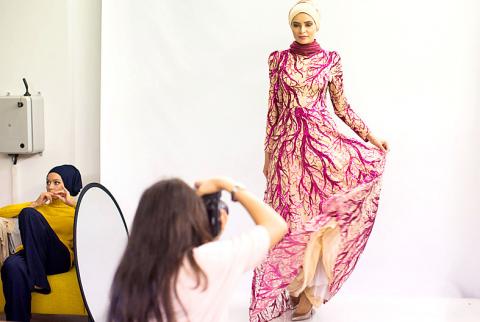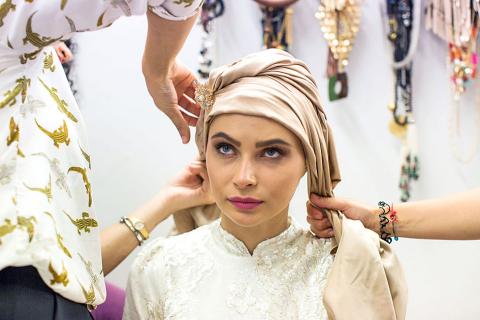The model adjusts her clothing, stares at the camera with a hint of a smile, holds her head high and the photographer starts snapping.
However, at this photoshoot on the Asian side of Istanbul, the models, impeccably made up, sport no body-hugging Western styles.
All wear headscarves and loose fitting outfits in a shoot for one of the industry’s fast growing sectors — modest, but trendy Islamic fashion.

Photo: AFP
Istanbul is positioning itself to be a hub in this nascent industry, which according to the Dubai-based Islamic Fashion and Design Council could be worth almost US$500 billion within decades.
Modanisa, a Turkish online Muslim clothing retailer, started small in 2011 and today is one of the biggest names in the market. It offers more than 30,000 products — from casual tunics to shiny evening wear to sports gear, shoes and accessories — from 300 brands and ships to 75 countries.
The firm calls itself the “first online fashion and shopping Web site for women who embrace a modest dressing style.” Modanisa chief executive Kerim Ture said that in years past there was so little choice that a religiously conservative young woman had no option but to wear the same clothes as her mother.

Photo: AFP
“If that was happening in a country [Turkey] where 99 percent of its population is Muslim, we wondered how the situation was around the world,” he added. “That’s how we’ve started our worldwide Web business.”
BURQINI BAN
Ture was surprised by this summer’s furor in strictly secular France over whether Muslim women had the right to wear the Burqini swimsuit, which covers all but the hands, feet and face.
French courts ultimately ruled that a Burqini ban by about 30 towns was “clearly illegal” and a violation of fundamental rights.
For Ture, the Burqini is not a symbol, but a choice.
“I barely understand how a country, one of whose main pillars is freedom, can oppose the Muslim swimsuit,” he said.
His firm’s catalogue offers a range of “fully closed swimsuits” starting at 40 euros (US$45), and, ironically, its Burqini sales jumped during the debate by 15 to 20 percent to France and 30 percent to the Netherlands.
In May, Istanbul hosted its first conservative fashion week at the historic Haydarpasa train station to showcase this rapidly growing market. It was organized by Franka Soeria from Indonesia, another center for Islamic clothing.
As a global consultant on modest fashion trends, Soeria decided three-and-a-half years ago to move to Istanbul — whose position straddling Europe and Asia, some say, gives it an edge.
The point of offering stylish modest clothing was not to tell people to cover up, but to show that “we are also the same as you ... we don’t want to be excluded, we don’t want to look different,” she said.
“We are showing that, hey, I am modest, I like to cover. I also like fashion. This is just my style. Just accept,” she said.
Osman Ozdemir, a Turkish designer of modest fashion, is the inhouse designer for Modanisa, but is now also working for several other firms.
“I believe Istanbul will be trend-setting on Islamic fashion,” he said. “Even high-profile and luxury brands are getting into the act.”
At the start of the year, legendary Italian fashion house Dolce & Gabbana launched its first line of hijab and abaya — some extravagantly patterned — for Muslim customers in the Middle East.
Though Turkey is a constitutionally secular state, the Islamic-rooted ruling Justice and Development Party, cofounded by Turkish President Recep Tayyip Erdogan, has advocated removing restrictions on the Muslim headscarf since it came to power in 2002.
In 2013, Turkey lifted a long-standing ban on wearing the hijab in state institutions. Last month, the government for the first time allowed policewomen to wear the headscarf under their official caps or berets.
In the conservative Fatih quarter of Istanbul, Islamic fashion stores line the streets, which are awash with billboards advertising modest styles.
“I covered my head three years ago. I didn’t want to dress up like my mother because in the past the clothes headscarf-wearing women could wear were limited,” 16-year-old shopper Seyma said. “Now I can easily find whatever I look for.”
Tourists from the Middle East are also coming to shop in Istanbul.
“I find many things: casual dresses, trousers, T-shirts and many pieces,” said Dalia, a young woman from Saudi Arabia. “I come without anything and buy from here.”
BACKLASH
Not all Turkish Muslims like the trend and see fashion as a Western tool aimed at turning Muslim women into consumer-oriented spenders.
“Islam seeks to form a modest Muslim identity, encouraging need-oriented consumption,” said Hulya Sekerci, an activist with the Free Thought and Education Rights Association, Ozgur-Der.
“On the contrary, fashion is a vicious circle encouraging excessive consumption. That’s why we are against fashion and fashion shows,” she said.
Hakan Yildiz, professor of political science at Istanbul’s Bosphorus University, said Islamic fashion stores were clearly proliferating in Turkey.
However, “we need at least a generation to see how it will evolve,” he said, adding that it would need “at least 20 years more to see if a Versace of Islam will emerge.”

The DBS Foundation yesterday announced the launch of two flagship programs, “Silver Motion” and “Happier Caregiver, Healthier Seniors,” in partnership with CCILU Ltd, Hondao Senior Citizens’ Welfare Foundation and the Garden of Hope Foundation to help Taiwan face the challenges of a rapidly aging population. The foundation said it would invest S$4.91 million (US$3.8 million) over three years to foster inclusion and resilience in an aging society. “Aging may bring challenges, but it also brings opportunities. With many Asian markets rapidly becoming super-aged, the DBS Foundation is working with a regional ecosystem of like-minded partners across the private, public and people sectors

Taiwan Semiconductor Manufacturing Co (TSMC, 台積電) has secured three construction permits for its plan to build a state-of-the-art A14 wafer fab in Taichung, and is likely to start construction soon, the Central Taiwan Science Park Bureau said yesterday. Speaking with CNA, Wang Chun-chieh (王俊傑), deputy director general of the science park bureau, said the world’s largest contract chipmaker has received three construction permits — one to build a fab to roll out sophisticated chips, another to build a central utility plant to provide water and electricity for the facility and the other to build three office buildings. With the three permits, TSMC

BREAKTHROUGH TECH: Powertech expects its fan-out PLP system to become mainstream, saying it can offer three-times greater production throughput Chip packaging service provider Powertech Technology Inc (力成科技) plans to more than double its capital expenditures next year to more than NT$40 billion (US$1.31 billion) as demand for its new panel-level packaging (PLP) technology, primarily used in chips for artificial intelligence (AI) applications, has greatly exceeded what it can supply. A significant portion of the budget, about US$1 billion, would be earmarked for fan-out PLP technology, Powertech told investors yesterday. Its heavy investment in fan-out PLP technology over the past 10 years is expected to bear fruit in 2027 after the technology enters volume production, it said, adding that the tech would

YEAR-END BOOST: The holiday shopping season in the US and Europe, combined with rising demand for AI applications, is expected to drive exports to a new high, the NDC said Taiwan’s business climate monitor improved last month, transitioning from steady growth for the first time in five months, as robust global demand for artificial intelligence (AI) products and new iPhone shipments boosted exports and corporate sales, the National Development Council (NDC) said yesterday. The council uses a five-color system to measure the nation’s economic state, with “green” indicating steady growth, “red” suggesting a boom and “blue” reflecting a recession. “Yellow-red” and “yellow-blue” suggest a transition to a stronger or weaker condition. The total score of the monitor’s composite index rose to 35 points from a revised 31 in August, ending a four-month